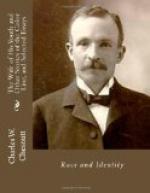There are no natural obstacles to such an amalgamation. The unity of the race is not only conceded but demonstrated by actual crossing. Any theory of sterility due to race crossing may as well be abandoned; it is founded mainly on prejudice and cannot be proved by the facts. If it come from Northern or European sources, it is likely to be weakened by lack of knowledge; if from Southern sources, it is sure to be colored by prejudices. My own observation is that in a majority of cases people of mixed blood are very prolific and very long-lived. The admixture of races in the United States has never taken place under conditions likely to produce the best results but there have nevertheless been enough conspicuous instances to the contrary in this country, to say nothing of a long and honorable list in other lands, to disprove the theory that people of mixed blood, other things being equal, are less virile, prolific or able than those of purer strains. But whether this be true or not is apart from this argument. Admitting that races may mix, and that they are thrown together under conditions which permit their admixture, the controlling motive will be not abstract considerations with regard to a remote posterity, but present interest and inclination.
The Indian element in the United States proper is so small proportionally—about one in three hundred—and the conditions for its amalgamation so favorable, that it would of itself require scarcely any consideration in this argument. There is no prejudice against the Indian blood, in solution. A half or quarter-breed, removed from the tribal environment, is freely received among white people. After the second or third remove he may even boast of his Indian descent; it gives him a sort of distinction, and involves no social disability. The distribution of the Indian race, however, tends to make the question largely a local one, and the survival of tribal relation may postpone the results for some little time. It will be, however, the fault of the United States Indian himself if he be not speedily amalgamated with the white population.




